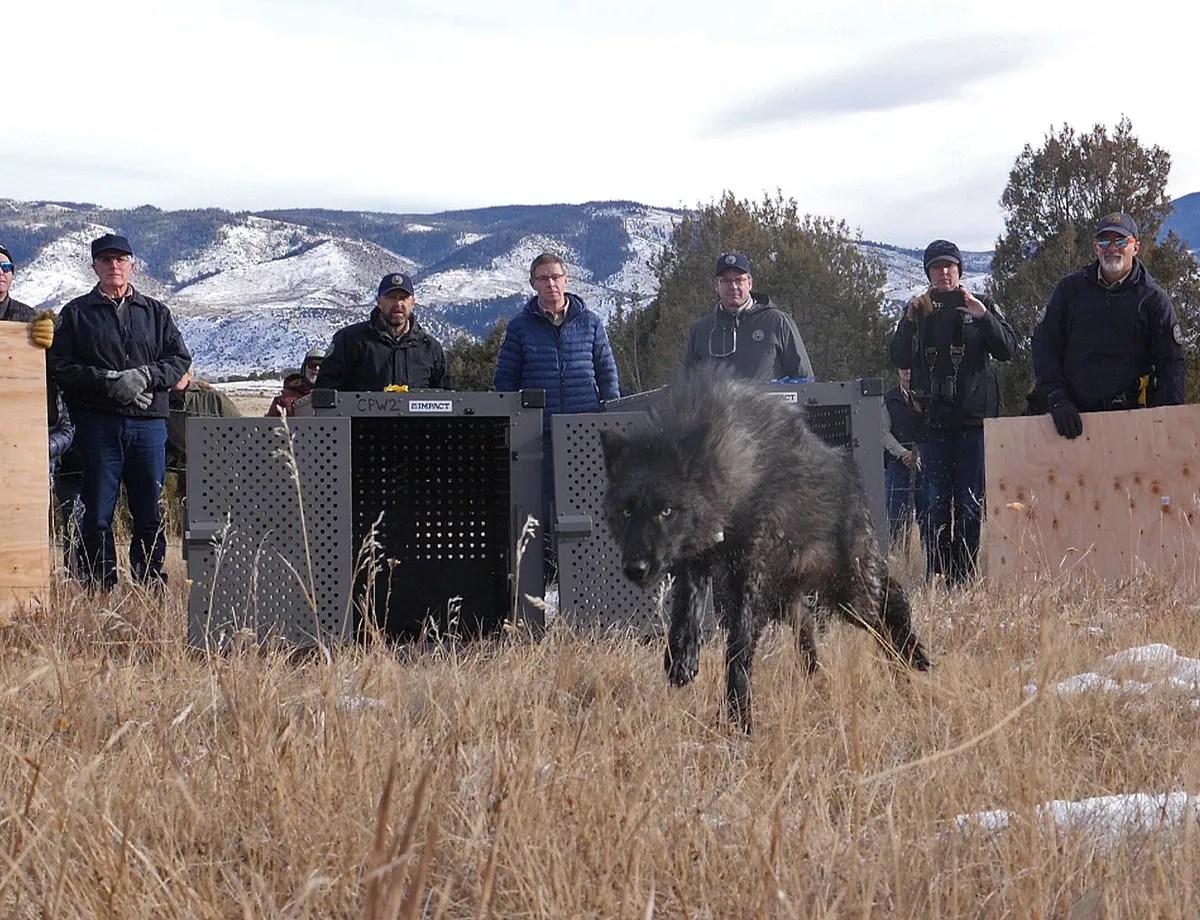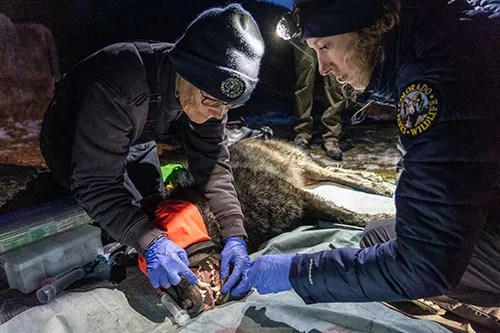
Colorado Parks and Wildlife agency Senior Video Producer Jerry Neal

Audio By Carbonatix
At the bottom of a grassy hill on state land in Grand County, Governor Jared Polis opened the door of a crate containing a gray wolf from Oregon – the first to be reintroduced to Colorado’s Western Slope as part of the 2023 Restoration and Management Plan – looking on like a proud parent on their kid’s first day of school.
“It was really inspiring to be there and see the wolves emerge from their crates and find a new home in Colorado like so many people have,” Polis told media members in a briefing on Monday, December 18, after watching the carnivores leap out one by one and bound up the hill to their new natural habitat in the Rockies.
“Whether you love wolves or whether you hate wolves, wolves are truly now a part of Colorado,” Polis said. “We know that there will be challenges ahead. We will learn to co-exist.”
The endangered species is being reintroduced to the Centennial State as a way to boost gray wolf numbers and was spurred in the state after years of expectation that the federal government would take on the project itself. Two pairs of juvenile male and female siblings from the same pack and one adult male from his own pack were released after being captured in Oregon by Colorado Parks and Wildlife on December 17. CPW hopes the group will be able to form their own pack that will be the start of a self-sustaining population of gray wolves in Colorado.
Voters passed Proposition 114 in November 2020, directing CPW to reintroduce wolves by the end of 2023. Despite two lawsuits aiming to prevent paws on the ground, the agency met that deadline Monday.
“That was a big thing to get to and get beyond that pressure and that expectation,” said Eric Odell, CPW’s wolf conservation program manager. “Seeing that happen was great, a huge relief. Just watching the animals leave the crate and run up the hillside – it’s a pretty majestic thing.”
Prior to the release, CPW notified local landowners in the area, according to Odell. The state obtained the five wolves – two with black coats and three with gray coats – and weighed and measured them, fitted each with a GPS collar and vaccinated them before flying them to Colorado overnight.

Colorado Parks and Wildlife veterinarian Pauline Nol and biologist Ellen Brandell examine one of the state’s new resident wolves.
Colorado Parks and Wildlife agency Northwest Public Information Officer Rachael Gonzales
“The animals stayed entirely calm the whole flight through, so there were no concerns there,” Odell recounted.
The path to this point hasn’t always been turbulence-free, however.
A point of discussion over the past year has been who supports Proposition 114 and who opposes it. The legislation passed with a majority of those in favor of reintroduction being from Colorado’s Front Range and those against hailing from rural areas and the Western Slope, where the animals were released.
To ensure that many voices were represented in its reintroduction plan, CPW assembled a Technical Working Group of reintroduction and management experts, as well as a Stakeholder Advisory Group of people from various geographic areas that might be impacted by wolf reintroduction, and took lots of public comment. In May, the Colorado Parks and Wildlife Commission approved the state’s final Wolf Restoration and Management Plan, which was highly informed by those groups.
“This is the first gray wolf reintroduction by a state agency,” Dan Gibbs, executive director of the Colorado Department of Natural Resources told media on Monday. “Once the Prop 114 vote was finalized, CPW staff went to work immediately to develop a plan and process to reintroduce wolves to Colorado that aligned with the will of the Colorado voters. It was fair and judicious to our agriculture and farming and ranching communities.”
Should wolves harm livestock or cause problems in any way, historically high dollar amounts have been listed for compensation, with state legislators passing bills to fund a wolf depredation compensation program and create a special wolf-themed license plate, the proceeds from which will go toward helping ranchers implement conflict prevention measures to protect their herds.
Still, many people in rural areas aren’t happy with the reintroduction, with at least two lawsuits being filed to attempt to stop the plan. The first came on December 11 from the Colorado Cattlemen’s Association (CCA) and the Gunnison County Stockgrowers Association (GCSA) in United States District Court. It argues that the U.S. Fish and Wildlife Service and CPW did not adequately complete a proper environmental review on the impacts of releasing wolves in the state.
“CCA and GCSA actively participated in developing the Colorado Parks and Wildlife Commission’s Wolf Management Plan as members expressed detailed oral and written concerns regarding the scope of impacts associated with the potential release,” the CCA said in a December 11 press release. “Those concerns and looming conflicts were not sufficiently resolved during that public process.”
Last week, a federal judge denied a temporary restraining order asking for reintroduction to be paused while the case goes on. The state can move forward with its plan in the meantime.
A similar lawsuit was filed by the Colorado Conservation Alliance on December 14.
The alliance describes itself as “a collaborative organization of private property landowners, ranchers, farmers, livestock producers, sportsmen and sportswomen, outfitters, natural resource affiliations, and businesses.” Its lawsuit argues that the wildlife agencies didn’t consider the possible impacts on the Mexican wolf, among other hypothetical concerns. No hearing has been set yet in the case.
CPW declined to comment on the suits, as advised by its legal counsel, but it did reaffirm its commitment to agricultural producers many times during the media briefing.
“That dedication isn’t just to getting wolves out on the ground,” said CPW director Jeff Davis. “That dedication and professionalism is definitely there to stand side by side with our rural communities and help them avoid and minimize livestock and wolf conflict moving forward.”
CPW worked with U.S. Fish and Wildlife to create a 10(j) designation for the reintroduction – effective December 8 – that allows the state to use wolf management strategies that include potentially injurious hazing and lethal control, which normally wouldn’t be allowed since wolves are a federally endangered species. Ranchers highly supported the designation throughout the process, with some state legislators attempting to pass a bill saying reintroduction could not happen without a 10(j). Polis vetoed that bill, but the 10(j) came through anyway. It is one of many pieces of the plan that wolf advocates cite to show it is designed to help rural communities as much as possible.
“Now the real work, that of coexistence, begins,” says Matt Barnes, a rangeland scientist who works on livestock-carnivore coexistence at the Northern Rockies Conservation Cooperative and was part of the CPW’s Stakeholder Advisory Group.
Speaking to Westword, Barnes points to efforts like donations from the Rocky Mountain Wolf Project, which originally pushed the reintroduction effort, and a collaboration between the Colorado State University Center for Human Carnivore Coexistence, the Northern Rockies Conservation Cooperative and Defenders of Wildlife to provide a fladry trailer for use in the state. Fladry is colored fabric that can be attached to fences to deter wolves.
Colorado Wolf Release 12-18-23 from Colorado Parks & Wildlife on Vimeo.
According to Commissioner of Agriculture Kate Greenberg, the Colorado Department of Agriculture and CPW also plan to work together to keep rural communities supported as wolves once again become part of the Colorado wilderness.
“This can be couched as the urban areas voted yes and the rural areas voted no,” Davis said. “Wolves just come with conflict. Always, in my experience. … We’re going to navigate this really well in a manner that truly respects the recovery of wolves in Colorado and makes sure that that coexistence with wolves and people and livestock is successful going forward.”
That success ultimately begins with the first five wolves.
Their CPW names are 2302-OR, 2303-OR, 2304-OR, 2305-OR and 2307-OR; the 23 refers to 2023; odd numbers are males and even are females and the OR indicates that they came from Oregon.
Colorado’s new species will be highly tracked in the coming months. Reid DeWalt, assistant director of the Aquatic, Terrestrial and Natural Resources branch at CPW explained that there will be around a twelve-hour delay in location data and that the department isn’t likely to make that data available right away.
“We’re still working through on how publicly available that will be,” he said Monday. “We’re really working to make sure the wolves are safe right now and not being tracked down for any reason. Once we establish where their home range is and where their pack territories will be, that will become much more publicly available.”
The CPW will repeat the capture and relocation process until at least ten to fifteen wolves come to Colorado, with mid-March 2024 as the targeted timeline for that to happen. It will release thirty to fifty over the next three to five years in accordance with the management plan.
“Most of us will never see wolves, but if we spend enough time in Colorado’s outback, we will hear them,” Barnes says. “Living and ranching with wolves won’t always be peaceful. Nature isn’t always pretty, but she sure is beautiful.”